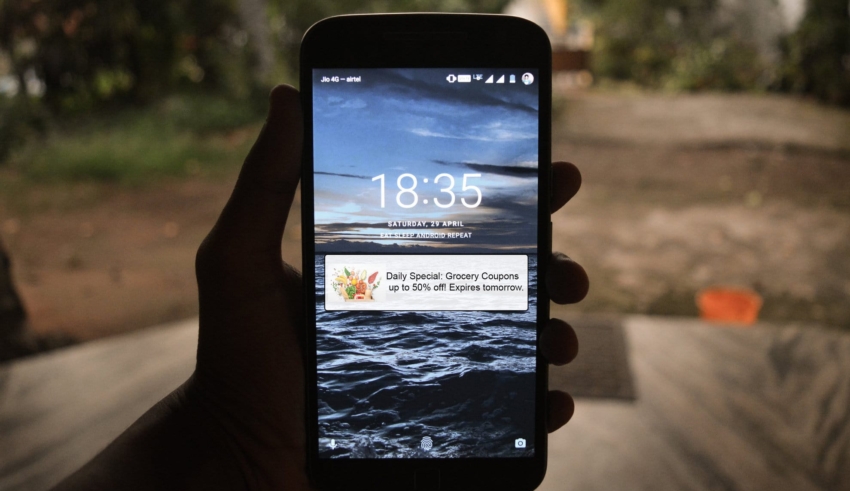
Most advertisers spend their entire budget chasing clicks on banner ads and social posts, wondering why their conversion rates stay stuck in single digits. Meanwhile, a different kind of ad format quietly delivers engagement rates that make traditional display look almost quaint by comparison.
Push notification ads don’t behave the way other digital advertising does. They show up on someone’s device whether or not they’re actively browsing. They bypass ad blockers entirely. And here’s the kicker—people actually opted in to receive them, which changes everything about how they respond.
The conversion advantage isn’t just theoretical. It’s measurable, repeatable, and becoming harder for serious advertisers to ignore.
Table of Contents
The Opt-In Factor Changes Everything
Banner ads interrupt. Push notifications arrive with permission.
That single difference reshapes the entire dynamic between advertiser and audience. When someone subscribes to push notifications from a website, they’re essentially raising their hand and saying they want to hear more. Not everyone does this casually. It’s a deliberate action that signals genuine interest in a topic, brand, or type of content.
This means the audience quality starts at a completely different baseline. These aren’t random visitors who happened to land on a page where an ad appeared. They’re people who took an extra step to stay connected. That intent matters when conversion time comes around.
Traditional display advertising casts a wide net and hopes for the best. Push notifications start with an audience that’s already somewhat qualified. The permission layer acts as a natural filter that weeds out the purely casual browsers before the advertising even begins.
Visibility That Banner Ads Can’t Match
Here’s the problem with most display ads: they live on web pages where they compete with everything else happening on screen. Articles, images, videos, navigation menus, comment sections—all of it fights for attention. A banner ad is just another element in a crowded visual space, and most people have trained themselves to ignore it completely.
Push notifications don’t have that problem. They appear directly on someone’s device, often with a distinctive sound or vibration. They show up on the lock screen or in the notification center. They demand attention in a way that banner ads simply can’t.
When someone receives a push notification, it’s right there in front of them. There’s no scrolling past it, no looking away, no pretending it doesn’t exist. They either engage with it or dismiss it, but they definitely see it. That guaranteed visibility is worth its weight in gold for advertisers tired of paying for impressions that never actually get viewed.
The delivery mechanism itself creates urgency. A notification feels timely and relevant in a way that a static banner ad never does. People check their phones constantly throughout the day, and each time they do, any pending notifications are right there waiting.
Timing Control That Actually Works
Display ads show up whenever someone happens to visit a website. Push notifications can be sent at strategically chosen moments.
This timing flexibility matters more than most advertisers realize. A retailer can send a push notification about a flash sale right when it goes live. A content publisher can alert subscribers the moment a highly anticipated article drops. A service business can reach potential customers during the exact hours when they’re most likely to need help.
The ability to control when someone sees the message—not just where—adds a dimension that traditional display advertising doesn’t offer. Testing different send times quickly reveals patterns about when a specific audience is most responsive. Some groups engage heavily during morning commutes. Others respond better in the evening. Push notifications make it possible to act on these insights instead of just observing them.
Frequency management also becomes more precise. Instead of hoping someone sees a banner ad enough times to remember it but not so many times they get annoyed, advertisers can set exact limits on how many push notifications someone receives per day or week. This prevents audience fatigue while maintaining consistent presence.
The Mobile-First Reality
More than half of all web traffic now comes from mobile devices, and that percentage keeps climbing. Push notifications were built specifically for this mobile-first world.
They work seamlessly on smartphones where screen real estate is limited and traditional banner ads often look cramped or out of place. A push notification on mobile feels native to the device in a way that other ad formats struggle to achieve. It uses the same interface as messages from friends, app updates, and other notifications people already interact with dozens of times daily.
This native feel reduces resistance. When an ad format blends naturally into how people already use their devices, it doesn’t feel like an intrusion. It feels like information arriving through normal channels. That psychological difference translates directly into higher engagement rates.
Mobile users are also more action-oriented than desktop users. They’re often on the go, making quick decisions, looking for immediate solutions. A well-timed push notification can catch someone at exactly the moment they’re ready to act, whether that’s making a purchase, signing up for something, or clicking through to learn more.
Better Performance Metrics Across the Board
The numbers tell a clear story. Push notification ads consistently show higher click-through rates than standard display advertising. We’re not talking about marginal improvements—the difference is often several multiples.
Part of this comes down to relevance. Because push subscribers chose to opt in, the messages they receive tend to align with their actual interests. A cooking website sends push notifications about recipes to people who deliberately subscribed for recipe updates. A tech news site reaches people who specifically want tech news alerts. This relevance matching happens automatically through the subscription process.
Conversion rates follow a similar pattern. When click-through rates are higher and the audience quality is better from the start, more of those clicks turn into actual conversions. Whether the goal is sales, sign-ups, downloads, or any other action, push notification campaigns typically deliver better results per dollar spent.
The cost structure also works differently. Since push notifications don’t rely on programmatic bidding wars or premium website placements, the cost per engagement often comes in lower than comparable display campaigns. Advertisers working with a push notification ad network can reach substantial audiences without the inflated CPMs that plague traditional display inventory.
Subscriber Lists That Keep Growing
Here’s something that doesn’t get enough attention: push notification audiences compound over time.
With banner ads, every impression is essentially starting from scratch. The audience for today’s campaign has no connection to yesterday’s audience. But with push notifications, each new subscriber becomes part of a growing list that can be reached again and again.
This creates a cumulative advantage. A website that builds a push notification subscriber base of 10,000 people in its first month has an asset that continues providing value. Those 10,000 people can receive future notifications at minimal cost. The list becomes an owned audience channel that doesn’t depend on buying impressions from third parties.
The economics shift dramatically once this subscriber base reaches a certain size. Early notifications essentially pay for themselves by driving enough conversions to fund list growth. Later notifications benefit from the full scale of the audience without the same acquisition costs. It’s a model that gets more efficient over time rather than less.
The Ad Blocker Problem Doesn’t Apply
Ad blocking software has become incredibly common, with some estimates suggesting nearly half of desktop users run some form of ad blocker. For traditional display advertising, this represents a huge chunk of potential impressions that simply never happen.
Push notifications slide right past this problem. They’re delivered through browser or app notification systems that ad blockers don’t touch. Someone can have the most aggressive ad blocking setup imaginable, and push notifications will still reach them without issue.
This means the audience size is what it appears to be. There’s no invisible loss of impressions to blocking software. Every subscriber actually receives every notification sent (assuming they haven’t manually disabled notifications, which is a different consideration). For advertisers who’ve watched their display campaign reach steadily decline as ad blocker adoption grows, this reliability is refreshing.
The format also sidesteps banner blindness, that phenomenon where people unconsciously ignore anything that looks like a display ad. Push notifications don’t look like ads in the traditional sense. They look like notifications, because that’s what they are. This visual difference helps them avoid the mental filters people have built up against advertising.
Testing and Optimization Happen Faster
Display ad campaigns often need to run for weeks before gathering enough data to make confident optimization decisions. Push notification campaigns can generate actionable insights much faster.
The immediacy of push delivery means results come in quickly. Send a notification at 3 PM, and by 3:30 PM there’s already solid data about how it performed. This rapid feedback loop makes it possible to test variables—headline copy, images, send times, audience segments—and iterate based on actual performance rather than assumptions.
A/B testing becomes more practical when results arrive within hours instead of weeks. An advertiser can test two different approaches in the morning and have a clear winner by afternoon. That winning approach can be scaled immediately while the losing version gets retired. This speed of learning compounds over time into campaigns that improve steadily based on real-world response data.
The format itself is also simpler to test. A push notification has fewer variables than a full display ad creative. There’s a headline, a brief message, and an image. Testing different combinations is straightforward and doesn’t require design resources or complex creative production. This simplicity removes friction from the optimization process.
Reaching People Beyond the Browse Session
Traditional display ads only work while someone is actively browsing websites. Close the browser, and the advertising stops reaching that person. Push notifications break this limitation entirely.
A subscriber can be reached days, weeks, or months after their last website visit. They don’t need to be actively browsing for the message to get through. This extended reach matters especially for products or services with longer consideration cycles.
Someone researching a major purchase might visit a website once, subscribe to notifications, and then take two weeks to make a decision. During those two weeks, push notifications can provide additional information, highlight new offers, or simply maintain brand presence. All of this happens without the person ever returning to the original website.
This ability to maintain contact over time transforms push notifications from a one-time impression into an ongoing communication channel. It’s closer to email marketing than to display advertising, but with significantly higher open rates and more immediate visibility.
Why the Format Keeps Getting Better
Push notification technology continues advancing while traditional display ads remain largely static. New features arrive regularly—rich media support, action buttons, interactive elements—that make the format more engaging and versatile.
The infrastructure behind push notifications is also improving. Delivery speeds are faster, targeting options are more granular, and analytics are more detailed. These improvements benefit all advertisers using the format, creating a rising tide effect where campaign performance naturally improves over time even without changes to strategy.
Browser support keeps expanding too. What started as a Chrome-specific feature now works across virtually all major browsers and operating systems. This universal compatibility means push notifications can reach audiences regardless of what device or browser they prefer. That cross-platform consistency is rare in digital advertising.
The Bottom Line
Push notification ads convert better because they solve problems that plague other formats. They reach people who actually want to be reached. They show up at chosen times instead of random moments. They bypass ad blockers and banner blindness. They work naturally on mobile devices where people spend most of their time.
The permission-based model ensures audience quality from the start. The visibility and timing advantages create more opportunities for engagement. The mobile-native format aligns with how people actually use their devices. And the cost structure often delivers better returns than comparable display campaigns.
For advertisers tired of pouring budget into display ads that get ignored, push notifications offer a genuinely different approach. The conversion advantages aren’t hype or theory—they’re showing up in campaign data across industries and audience types. As more advertisers discover what the format can do, the ones who adopt it early gain an edge that compounds over time.















